| dc.contributor.author | Nigam, S. |
| dc.contributor.author | Waliyar, F. |
| dc.contributor.author | Aruna, R. |
| dc.contributor.author | Reddy, S. |
| dc.contributor.author | Kumar, P.L. |
| dc.contributor.author | Craufurd, Peter Q. |
| dc.contributor.author | Diallo, A. |
| dc.contributor.author | Ntare, B.R. |
| dc.contributor.author | Upadhyaya, Hari D. |
| dc.date.accessioned | 2019-12-04T11:11:43Z |
| dc.date.available | 2019-12-04T11:11:43Z |
| dc.date.issued | 2009 |
| dc.identifier.citation | Nigam, S., Waliyar, F., Aruna, R., Reddy, S., Kumar, P.L., Craufurd, P. & Upadhyaya, H. Breeding peanut for resistance to aflatoxin contamination at ICRISAT. Peanut Science, 36(1), 42-49. |
| dc.identifier.issn | 0095-3679 |
| dc.identifier.uri | https://hdl.handle.net/20.500.12478/2484 |
| dc.description.abstract | Peanut plays an important role in the liveli-hoods of poor farmers and in the rural economy ofmany developing countries. Aflatoxin contamina-tion in peanut seeds, caused byAspergillus flavus,hampers international trade and adversely affectshealth of consumers of peanut and its products. Itcan occur in the field when the crop is growing,during harvesting and curing, and in storage andtransportation. Aflatoxin research on peanut atICRISAT focuses on identification and utilizationof genetic resistance to preharvest seed infectionand aflatoxin production byA. flavusand pre andpost harvest management practices to minimizecontamination. Breeding for aflatoxin resistancehas been a contentious issue in peanut for nearlyfour decades since the first report of hostresistance to aflatoxin production byA. flavus.Despite global efforts, progress in aflatoxinresistance breeding has been limited due to thelow level of resistance to different components ofresistance (preharvest seed infection and aflatoxinproduction, andin vitroseed colonization byA.flavus), their variable performance due to highG3E interaction, lack of reliable screeningprotocols, and limited understanding of geneticsof resistance. Efforts to combine the threeindependently inherited components of resistancedid not produce expected results towards improv-ing the host plant resistance to aflatoxin contam-ination. Although breeding lines have shownbetter performance for resistance to aflatoxincontamination at ICRISAT, they need widerevaluation under diverse growing conditions.The search for better sources of resistance in thecultivated and wildArachisgermplasm continues,and recent developments in the area of transgenicresearch through modification of aflatoxin bio-synthesis pathway or use of genes with antifungaland anti-aflatoxin properties appear encouraging.Meanwhile, the available improved breeding linescoupled with pre and post harvest aflatoxinmanagement practices can help to significantlyreduce aflatoxin contamination in farmers’ fields.It is expected that transgenic resistance againstfungal infection and aflatoxin production incombination with conventional breeding effortsmay lead to the development of agronomicallysuperior peanuts that are free of aflatoxincontamination. |
| dc.format.extent | 42-49 |
| dc.language.iso | en |
| dc.subject | Groundnuts |
| dc.subject | Arachis Hypogaea |
| dc.subject | Aspergillus Flavus |
| dc.subject | Preharvest Seed Infection |
| dc.subject | In Vitro Seed Colonization |
| dc.subject | On-Farm Evaluation |
| dc.title | Breeding peanut for resistance to aflatoxin contamination at ICRISAT |
| dc.type | Journal Article |
| dc.description.version | Peer Review |
| cg.contributor.affiliation | International Crops Research Institute for the Semi-Arid Tropics |
| cg.contributor.affiliation | International Institute of Tropical Agriculture |
| cg.contributor.affiliation | University of Reading |
| cg.coverage.region | Acp |
| cg.coverage.region | Africa |
| cg.coverage.region | South Asia |
| cg.coverage.region | West Africa |
| cg.coverage.region | Europe |
| cg.coverage.country | India |
| cg.coverage.country | Niger |
| cg.coverage.country | Nigeria |
| cg.coverage.country | United Kingdom |
| cg.coverage.country | Mali |
| cg.isijournal | ISI Journal |
| cg.authorship.types | CGIAR and developing country institute |
| cg.iitasubject | Aflatoxin |
| cg.iitasubject | Biofortification |
| cg.iitasubject | Crop Husbandry |
| cg.iitasubject | Disease Control |
| cg.iitasubject | Food Science |
| cg.iitasubject | Plant Breeding |
| cg.iitasubject | Plant Diseases |
| cg.iitasubject | Pests Of Plants |
| cg.iitasubject | Plant Production |
| cg.journal | Peanut Science |
| cg.howpublished | Formally Published |
| cg.accessibilitystatus | Limited Access |
| local.dspaceid | 93235 |
| cg.identifier.doi | https://dx.doi.org/10.3146/AT07-008.1 |

